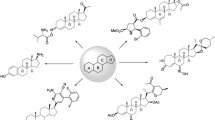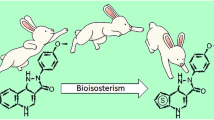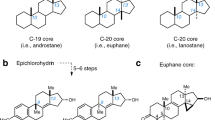Abstract
Most of reported steroidal FXR antagonists are restricted due to low potency. We described the design and synthesis of novel nonsteroidal scaffold SIPI-7623 derivatives as FXR antagonists. The most potent compound A-11 (IC50 = 7.8 ± 1.1 μM) showed better activity compared to SIPI-7623 (IC50 = 40.8 ± 1.7 μM) and guggulsterone (IC50 = 45.9 ± 1.1 μM). Docking of A-11 in FXR’s ligand-binding domain was also studied.









Similar content being viewed by others
Abbreviations
- FXR:
-
Farnesoid X receptor
- LBD:
-
Ligand-binding domain
- GS:
-
Guggulsterone
- TC:
-
Total cholesterol
- TG:
-
Triacylglycerol
- LDL-C:
-
Low-density lipoprotein cholesterol
References
Jin J, Sun X, Zhao Z, Wang W, Qiu Y, Fu X, Huang M, Huang Z (2015) Activation of the farnesoid X receptor attenuates triptolide-induced liver toxicity. Phytomedicine 22:894–901. https://doi.org/10.1016/j.phymed.2015.06.007
Yang L, Broderick D, Campbell Y, Gombart AF, Stevens JF, Jiang Y, Hsu VL, Bisson WH, Maier CS (2016) Conformational modulation of the farnesoid X receptor by prenylflavonoids: Insights from hydrogen deuterium exchange mass spectrometry (HDX-MS), fluorescence titration and molecular docking studies. Biochim Biophys Acta 1864:1667–1677. https://doi.org/10.1016/j.bbapap.2016.08.019
Gioiello A, Cerra B, Mostarda S, Guercini C, Pellicciari R, Macchiarulo A (2014) Bile acid derivatives as ligands of the farnesoid x receptor: molecular determinants for bile acid binding and receptor modulation. Curr Top Med Chem 14:2159–2574. https://doi.org/10.2174/1568026614666141112100208
Song K, Xu X, Liu P, Chen L, Shen X, Liu J, Hu L (2015) Discovery and SAR study of 3-(tert-butyl)-4-hydroxyphenyl benzoate and benzamide derivatives as novel farnesoid X receptor (FXR) antagonists. Bioorg Med Chem 23:6427–6436. https://doi.org/10.1016/j.bmc.2015.08.021
Gioiello A, Cerra B, Mostarda S, Guercini C, Pellicciari R, Macchiarulo A (2014) Beyond bile acids: targeting Farnesoid X Receptor (FXR) with natural and synthetic ligands. Curr Top Med Chem 14:2129–2142. https://doi.org/10.2174/1568026614666141112094058
Huang H, Yu Y, Gao Z, Zhang Y, Li C, Xu X, Jin H, Yan W, Ma R, Zhu J, Shen X, Jiang H, Chen L, Li J (2012) Discovery and optimization of 1,3,4-trisubstituted-pyrazolone derivatives as novel, potent, and nonsteroidal farnesoid X receptor (FXR) selective antagonists. J Med Chem 55:7037–7053. https://doi.org/10.1021/jm3002718
Xu X, Xu X, Liu P, Zhu ZY, Chen J, Fu HA, Chen LL, Hu LH, Shen X (2015) Structural basis for small molecule NDB (N-benzyl-N-(3-(tert-butyl)-4-hydroxyphenyl)-2,6-dichloro-4-(dimethylamino) benzamide) as a selective antagonist of farnesoid X receptor α (FXRα) in stabilizing the homodimerization of the receptor. J Biol Chem 290:19888–19899. https://doi.org/10.1074/jbc.M114.630475
Huang H, Xu Y, Zhu J, Li J (2014) Recent advances in non-steroidal FXR antagonists development for therapeutic applications. Curr Top Med Chem 14:2175–2187. https://doi.org/10.2174/1568026614666141112101840
Lamers C, Schubert-Zsilavecz M, Merk D (2014) Medicinal chemistry and pharmacological effects of farnesoid X receptor (FXR) antagonists. Curr Top Med Chem 14:2188–2205. https://doi.org/10.2174/1568026614666141112103516
Bellale E, Naik MVBV, Ambady A, Narayan A, Ravishankar S, Ramachandran V, Kaur P, McLaughlin R, Whiteaker J, Morayya S, Guptha S, Sharma S, Raichurkar A, Awasthy D, Achar V, Vachaspati P, Bandodkar B, Panda M, Chatterji M (2014) Diarylthiazole: an antimycobacterial scaffold potentially targeting PrrB-PrrA two-component system. J Med Chem 57:6572–6682. https://doi.org/10.1021/jm500833f
Maitrani C, Heyes DJ, Hay S, Arumugam S, Popik VV, Phillips RS (2012) Preparation and photophysical properties of a caged kynurenine. Bioorg Med Chem Lett 22:2734–2737. https://doi.org/10.1016/j.bmcl.2012.02.097
Uddin MJ, Elleman AV, Ghebreselasie K, Daniel CK, Crews BC, Nance KD, Huda T, Marnett LJ (2014) Design of fluorine-containing 3,4-diarylfuran-2(5H)-ones as selective COX-1 Inhibitors. ACS Med Chem Lett 5:1254–1258. https://doi.org/10.1021/ml500344j
McKervey MA, O’Sullivan MB, Myers PL (1993) Reductive acylation of α-keto azides derived from l-amino acids using N-protected l-aminothiocarboxylic s-acids. J Chem Soc Chem Commun 1:94–96. https://doi.org/10.1002/chin.199317106
Atta AK, Kim SB, Cho DG (2011) Catalytic oxidative conversion of aldehydes to carboxylic esters and acids under mild conditions. Bull Korean Chem Soc 32:2070–2072. https://doi.org/10.5012/bkcs.2011.32.6.2070
LaDow JE, Warnock DC, Hamill KM, Simmons KL, Davis RW, Schwantes CR, Flaherty DC, Willcox JA, Wilson-Henjum K, Caran KL, Minbiole KP, Seifert K (2011) Bicephalic amphiphile architecture affects antibacterial activity. Eur J Med Chem 46:4219–4226. https://doi.org/10.1016/j.ejmech
Lee YZ, Chen X, Chen SA, Wei PK, Fann WS (2001) Soluble electroluminescent poly(phenylene vinylene)s with balanced electron- and hole injections. J Am Chem Soc 123:2296–2307. https://doi.org/10.1021/ja003135d
Mueller R, Yang J, Duan C, Pop E, Zhang LH, Huang TB, Denisenko A, Denisko OV, Oniciu DC, Bisgaier CL, Pape ME, Freiman CD, Goetz B, Cramer CT, Hopson KL, Dasseux JL (2004) Long hydrocarbon chain ether diols and ether diacids that favorably alter lipid disorders in vivo. J Med Chem 47:5183–5197. https://doi.org/10.1021/jm0400395
Chakraborti AK, Chankeshwara SV (2009) Counterattack mode differential acetylative deprotection of phenylmethyl ethers: applications to solid phase organic reactions. J Org Chem 74:1367–1370. https://doi.org/10.1021/jo801659g
Yu DD, Lin W, Chen T, Forman BM (2013) Development of time resolved fluorescence resonance energy transfer-based assay for FXR antagonist discovery. Bioorg Med Chem 21:4266–4278. https://doi.org/10.1016/j.bmc.2013.04.069
Goldwasser J, Cohen PY, Yang E, Balaguer P, Yarmush ML, Nahmias Y (2010) Transcriptional regulation of human and rat hepatic lipid metabolism by the grapefruit flavonoid naringenin: role of PPARalpha, PPARgamma and LXRalpha. PLoS ONE 5:e12399. https://doi.org/10.1371/journal.pone.0012399
Maestro, version 9.9 (2014) Schrödinger. LLC, New York, NY. www.schrodinger.com
Acknowledgements
The work was supported by National Natural Science Foundation of China (No. 81660571), Guangxi Natural Science Foundation of China (No. 2015GXNSFBA139124) and “Scientific and Technological Innovation Plan” (No. 16431903900) from Science and Technology Commission of Shanghai Municipality. The authors are very thankful to shanghai ChemPartner Co., Ltd and WuXi AppTec for experimental assistance.
Author information
Authors and Affiliations
Corresponding author
Electronic supplementary material
Below is the link to the electronic supplementary material.
Rights and permissions
About this article
Cite this article
Nian, SY., Wang, GP., Jiang, ZL. et al. Synthesis and biological evaluation of novel SIPI-7623 derivatives as farnesoid X receptor (FXR) antagonists. Mol Divers 23, 19–33 (2019). https://doi.org/10.1007/s11030-018-9843-2
Received:
Accepted:
Published:
Issue Date:
DOI: https://doi.org/10.1007/s11030-018-9843-2




